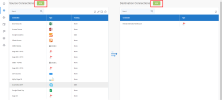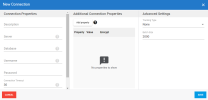Adding a Source and Destination Connection
In order to extract your data, you need to add a source and a destination connection.
- Adding a source connection specifies the data source on which your data will be retrieved through the extraction process. Once the data is taken from the source connection, it needs a location to be stored, hence the destination connection.
- Adding a destination connection specifies the place in which your data will be integrated in order to be read once transformed.
To add a source or a destination connection:
-
Click the Connections icon on the left-hand side.
-
Click New next to Source Connections or Destination Connections.
-
Select the type of data source you want to use.
Source connections
Destination connections
Active Directory
Acumatica
Custom API
Flat File
Google Analytics
Google Sheets
HubSpot
LDAP
Microsoft Access
Microsoft Excel
MySQL
NetSuite
OData
ODBC
Oracle
PostgreSQL
Quickbooks Desktop
Quickbooks Online
Sage Business Cloud
Sage Intacct
Sage 50 UK
Salesforce
SAP HANA
SQL Azure
SQL RDS
SQL Server
Flat File
Oracle
SQL Azure
SQL RDS
SQL Server
 Web API source connections
Web API source connections
Aweber
Accelo
AdRoll
AfterShip
AgileCRM
Aha!
Aircall
Amplitude
Autopilot
Avaza
BambooHR
BenchmarkEmail
Billsby
Bugsnag
Calendly
CampaignMonitor
Campaigner
CapsuleCRM
ChargeOver
Chargebee
ClickTime
ClickUp
Clio
Close CRM
Codat
Coinbase
ConstantContact
Contactually
ConvertKit
Copper CRM
Delighted
Dotmailer
Drift
Drip
Egnyte
Elorus
EmailOctopus
Eventbrite
Everhour
Figshare
Float
Flowlu
FreeAgent
Freshsales
Freshservice
Freshteam
Front
GetResponse
Gorgias
Grafana
Harvest
HelloSign
Helpscout
Hive
Hubstaff
Humanity
iContact
Infusionsoft
Insightly
Intercom
Invoiced
JotForm
Jumpseller
Klaviyo
Klipfolio
LaunchDarkly
LeadDesk
LightSpeedRetail
LionDesk
MailerLite
Mailjet
MessageBird
Mode
Moosend
Mouseflow
Nethunt
Omnisend
OnePageCrm
Ontraport
Opsgenie
Optimizely
PabblySubscriptions
PagerDuty
Paymo
Pingdom
Pipeline CRM
Pipeliner CRM
PivotalTracker
Planio
PolarTeamPro
Printful
Printify
Procore
Quaderno
Rebilly
Recurly
Retently
SageHR
Samanage
SendInBlue
SendPulse
Sendwithus
ShipEngine
Shippo
SpaceX
SparkPost
Stack Exchange
Tanda
Teamgate
Teamwork
Testmonitor
Tickspot
Timely
Todoist
Toggl
Typeform
Unbounce
VWO
Wistia
Wrike
Yelp
ZarMoney
ZendeskSell
Zenefits
ZohoDesk
ZohoInventory
ZohoInvoice
ZohoMarketingHub
ZohoPeople
ZohoProjects
ZohoSubscriptions
Zoom
Your Custom API
Note: Versions prior to SQL Server 2008 R2 are not supported.
-
The New Connection dialog box is displayed. Enter the parameters in the following panels: Connection Properties, Additional Connection Properties and Advanced Settings as described below.
- Click Save to finish.
| Setting | Description |
|---|---|
|
Connection Properties |
According to the connection selected, the fields will be different from one connection to another due to their characteristics. For more information about each source connection type, see Connector Settings. Tool tips located next to each field are available to help you setting up some fields. Feel free to take a look to get more details if needed. |
|
Additional Connection Properties This panel can be used to add specific properties to the connection string. |
|
| Add Property |
Click this button if you want to specify some properties for this connection. For each property you add, you can define if you want it to be encrypted or not (i.e. visible). If you choose Encrypted, the value of the property (ex: password) will not be shown on the screen and will be encrypted in the back end. |
| Property | Enter a connection string which defines the action you want to perform (ex: READ). |
| Value |
According to the property you entered, you can set the state (for example : TRUE or FALSE). |
| Encrypt |
Select this option if you want to encrypt data related to the property. |
| Delete |
Click on the X sign to delete the property. |
|
This panel is available for some source connections. |
|
| Tracking Type |
Date: the synchronization between the source and the destination will be incremental as it will be based on the latest update values of the DateTime entry of each row. Note: Sage X3 for instance used the field UPDDATTIM_0 as DateTime while in Sage 300 the DateTime is divided into 2 separate fields (AUDTDATE and AUDTTIME). For the case of Sage 300, you will have to create a calculated field first to merge these fields then to convert them into a "real" DateTime field in order to work properly. |
|
Time Zone (if you select Date as tracking type |
Defines the region and time zone that will be used by the source connection. |
|
Time Offset (if you select Date as tracking type) |
Adds an offset to the source connection that will be used for Incremental Load job (Minimal value is 0 and maximum 3600 seconds). |
|
Batch Size |
The batch size represents the quantity of data read, transform and load in the destination at the same time. To set the value, remember that the bigger the batch size is the bigger the memory usage will be and the faster it will be up to an extend. The default value is 2000 and the maximum value should not be set to more than 10 000. Based on your network speed and disk performance, you can experiment which size of block would be faster for you. Usually the default value (2000 records) works fine. |
If DataSync is not installed on the same server as your ERP application, please check that the minutes and seconds in the two servers match. Use the Time Offset feature (in seconds) if there is a difference. You can enter a number greater than the difference to ensure optimal data retrieval during an Incremental Load task.
A client imports an Excel file that has a lot of transactions (1000 rows).
While processing the transactions with a job, a small time gap exists during the time period between when the job has finished submitting the rows and when the system has stamped the last success date (DateTime.Now (meaning the current time)).
During that time period, imagine that a few rows have been added (for example, 5 rows, so there are now 1005 rows) and the client does a refresh (Incremental Load). Since the refresh is based on the last success date, it will skip the 5 new rows that came after the job has finished but before the timestamp was done by the system.
Adding an offset to the connection can fix that problem because it removes the time gap.


